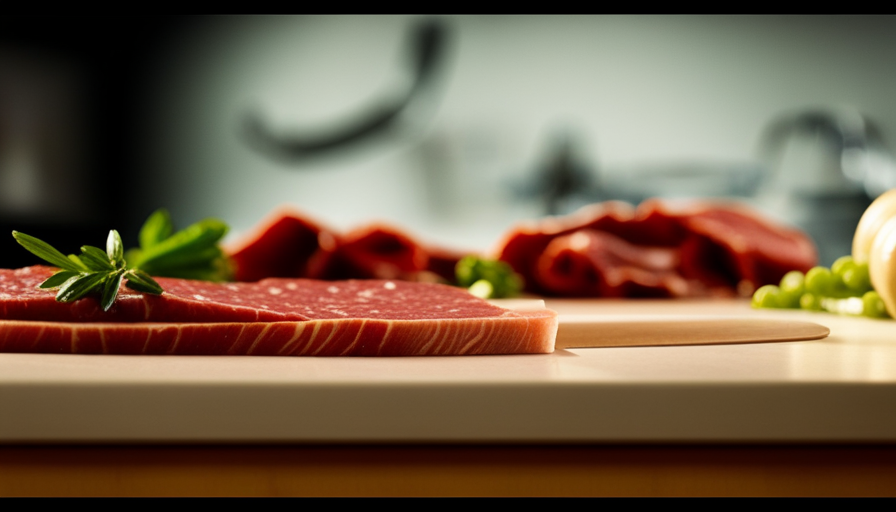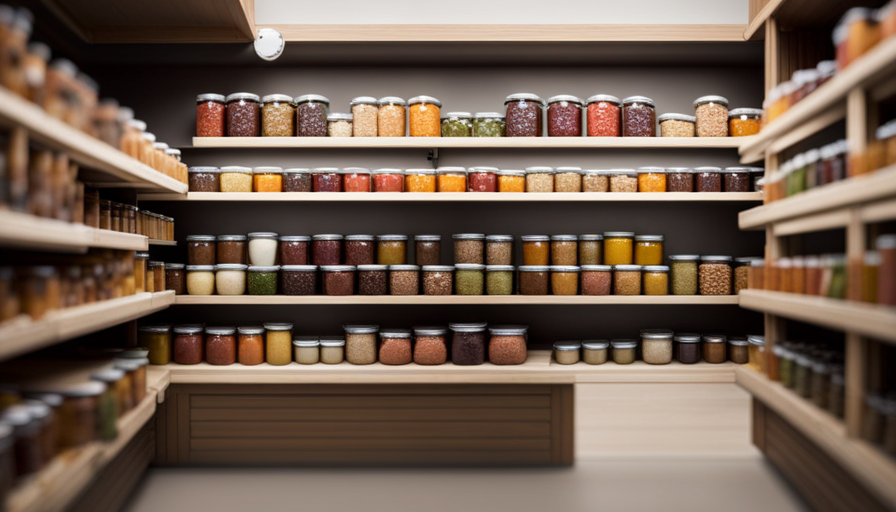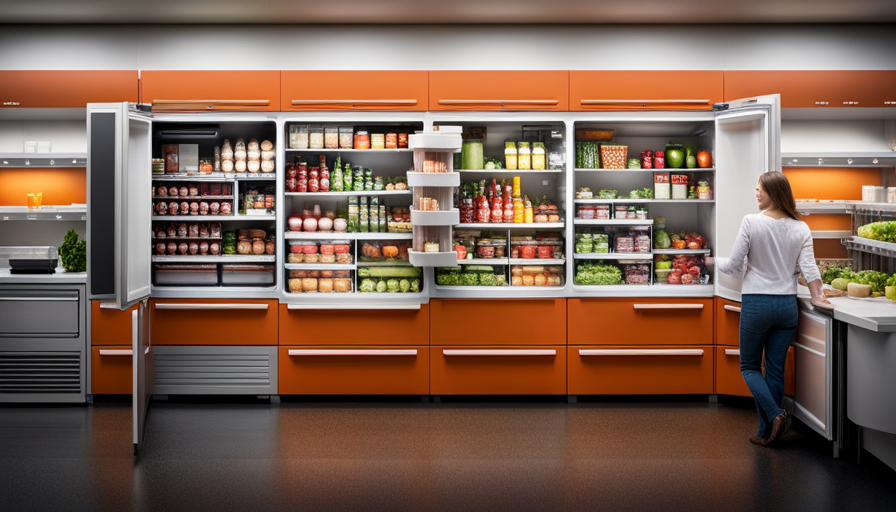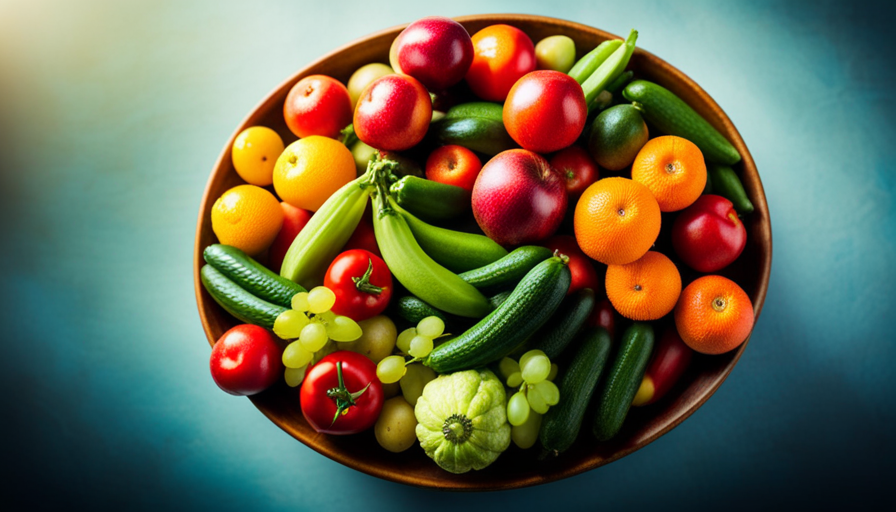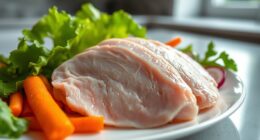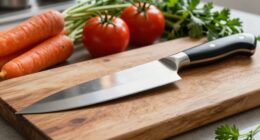Imagine your kitchen as a battleground, where unseen foes lie in wait, ready to strike. These adversaries are pathogens, tiny organisms that have the potential to make us sick or worse, if not dealt with effectively. One of the primary ways these harmful contaminants enter our homes is through raw meat, which can easily spread dangerous bacteria onto our cooking areas.
But fear not, for in this article, we will arm you with the knowledge and techniques to wage war against these pathogens and ensure the safety of your meals.
Clean and safe food preparation surfaces are of utmost importance in maintaining a healthy kitchen. It is crucial to understand the pathogenesis of these contaminants and the risks they pose to your well-being. By implementing proper hygiene practices, such as thorough cleaning and disinfection, you can effectively eliminate pathogens from raw meat surfaces.
Preventing cross-contamination is another essential aspect, as it can easily spread harmful bacteria to other areas of your kitchen.
Regular maintenance and inspection of surfaces, along with training and education for food handlers, play vital roles in promoting food safety. By raising awareness and instilling proper practices, we can all contribute to a safer and healthier food preparation environment.
So, prepare to arm yourself with the knowledge and techniques to eliminate pathogenesis on food preparation surfaces, and let the battle for food safety begin!
Key Takeaways
- Proper hygiene practices such as cleaning and disinfection can eliminate pathogens from raw meat surfaces.
- Cross-contamination can easily spread harmful bacteria to other areas of the kitchen.
- Precautions like keeping raw meat separate and using separate cutting boards can help prevent contamination.
- Thoroughly washing hands before and after handling raw meat helps prevent cross-contamination.
Understanding Pathogenic Contamination
Let’s dive into understanding how those pesky pathogens contaminate our food and how we can tackle them on our food preparation surfaces where raw meat is handled. Preventing foodborne illnesses is crucial, and a key aspect of this is understanding bacterial growth.
Bacteria are microscopic organisms that can cause illness when they contaminate our food. They can be found in raw meat, poultry, seafood, and even fruits and vegetables. When these foods come into contact with surfaces like cutting boards, knives, or countertops, bacteria can easily transfer and multiply.
Understanding bacterial growth is essential in preventing foodborne illnesses. Bacteria need certain conditions to thrive, including moisture, warmth, and nutrients. On food preparation surfaces, these conditions can be created when raw meat comes into contact with the surface and leaves behind tiny bits of juice or residue.
To eliminate pathogenic contamination, it is important to take proper precautions. Start by keeping raw meat separate from other foods and using separate cutting boards and utensils for raw meat and other ingredients. Wash your hands thoroughly before and after handling raw meat, and clean food preparation surfaces with hot, soapy water.
By understanding how pathogens contaminate our food and implementing proper hygiene practices, we can greatly reduce the risk of foodborne illnesses. So, let’s be vigilant in our food preparation and ensure that our surfaces are clean and safe for cooking.
Importance of Clean and Safe Food Preparation Surfaces
It’s crucial to keep our cooking areas spick and span to ensure a delightful and germ-free culinary experience. One of the most important aspects of maintaining cleanliness in the kitchen is ensuring that food preparation surfaces are clean and safe. These surfaces can easily become contaminated with pathogens from raw meat, which can lead to foodborne illnesses if not properly eliminated.
To effectively eliminate pathogens on food preparation surfaces, it is essential to use appropriate cleaning methods. Regularly washing surfaces with hot, soapy water is a good starting point. This helps to remove dirt and debris, as well as some of the microorganisms present. Additionally, using disinfectants specifically designed for food surfaces can further reduce the risk of contamination. These disinfectants should be used according to the manufacturer’s instructions, ensuring proper contact time for maximum effectiveness.
In order to emphasize the importance of clean and safe food preparation surfaces, let’s take a look at the following table:
| Cleaning Method | Benefits | Drawbacks |
|---|---|---|
| Hot, soapy water | Removes dirt and debris | May not eliminate all pathogens |
| Food surface disinfectants | Effective against pathogens | Some may not be safe for food contact |
| Vinegar solution | Natural and non-toxic | Limited effectiveness on pathogens |
| Bleach solution | Strong disinfectant properties | May damage certain surfaces |
| Steam cleaning | Kills a wide range of pathogens | Requires specialized equipment |
By utilizing these cleaning methods, we can greatly reduce the risk of foodborne illnesses caused by pathogenic contamination on food preparation surfaces. Remember, keeping our cooking areas clean is not only essential for our health but also for the enjoyment of our meals.
Proper Hygiene Practices in the Kitchen
To ensure a clean and safe kitchen environment, remember to practice proper hygiene by washing your hands frequently, using separate cutting boards for different ingredients, and regularly sanitizing utensils and equipment. By following these simple steps, you can prevent the growth of harmful bacteria and reduce the risk of foodborne illnesses.
Here are four important practices to incorporate into your kitchen routine:
-
Proper handwashing techniques: Thoroughly wash your hands with warm water and soap for at least 20 seconds before and after handling raw meat or any other ingredients. This helps remove any potential pathogens from your hands and prevents cross-contamination.
-
Use separate cutting boards: Raw meat can contain harmful bacteria that can easily spread to other foods. To avoid cross-contamination, it’s essential to use separate cutting boards for raw meat, poultry, seafood, and vegetables. This prevents the transfer of bacteria from one food to another.
-
Sanitize utensils and equipment: Regularly sanitize all utensils, knives, and equipment used in food preparation. This can be done by washing them with hot, soapy water and using a sanitizing solution or dishwasher. Sanitizing helps kill any remaining bacteria and ensures a safe cooking environment.
-
Clean and disinfect food preparation surfaces: After each use, thoroughly clean and disinfect all food preparation surfaces, such as countertops and cutting boards. Use a solution of bleach and water or a commercial disinfectant to kill any bacteria that may be present.
By incorporating these proper hygiene practices into your kitchen routine, you can minimize the risk of bacterial growth and ensure a clean and safe food preparation environment.
Effective Cleaning Techniques for Raw Meat Surfaces
Ensure your kitchen is safe and clean by effectively cleaning surfaces where you handle and prepare raw meat. Proper cleaning techniques are essential to eliminate any potential pathogens and reduce the risk of foodborne illnesses. By using effective cleaning products and following best practices, you can ensure a hygienic environment in your kitchen.
To effectively clean surfaces where raw meat is used, it is important to use cleaning products that are specifically designed to kill bacteria. Look for disinfectants that are labeled as effective against foodborne pathogens such as Salmonella and E. coli. These products should be used according to the manufacturer’s instructions for maximum effectiveness.
In addition to using effective cleaning products, it is also important to follow proper cleaning procedures. Start by removing any visible debris from the surface, such as meat scraps or crumbs. Then, apply the cleaning product and allow it to sit for the recommended amount of time to ensure that all bacteria are killed. Finally, rinse the surface thoroughly with hot water to remove any residue.
By effectively cleaning surfaces where raw meat is handled, you can greatly reduce the risk of bacterial growth and contamination. Remember to always follow proper hygiene practices in the kitchen and use effective cleaning products to ensure a safe and clean cooking environment.
Using Antibacterial Solutions for Disinfection
Using antibacterial solutions is a wise choice to effectively disinfect your kitchen and keep it free from harmful pathogens. These solutions contain chemicals that can kill bacteria and other microorganisms on surfaces, reducing the risk of contamination. Here are three reasons why using antibacterial solutions is beneficial:
-
Efficient disinfection: Antibacterial solutions are specifically formulated to kill bacteria and other pathogens. They’re designed to be effective in eliminating a wide range of microorganisms, including those that can cause foodborne illnesses. By using these solutions, you can ensure that your kitchen surfaces are thoroughly disinfected, minimizing the risk of cross-contamination.
-
Antibacterial resistance prevention: Antibacterial resistance is a growing concern in modern medicine and agriculture. Overuse or misuse of antibacterial agents can lead to the development of resistant bacteria that are difficult to treat. However, when used correctly and in moderation, antibacterial solutions can help prevent the spread of resistant bacteria in your kitchen. By following the instructions on the product label and using the solutions only when necessary, you can contribute to the fight against antibacterial resistance.
-
Alternative disinfection methods: While antibacterial solutions are effective, it’s important to consider alternative disinfection methods as well. Some natural products, such as vinegar or lemon juice, can also have antimicrobial properties and be used as alternatives to commercial antibacterial solutions. However, it’s important to note that these natural alternatives may not be as effective as the chemical-based solutions, especially against certain pathogens. Additionally, always ensure proper food safety practices, such as proper food storage, thorough cooking, and regular cleaning, to complement the use of antibacterial solutions or alternative disinfection methods.
Sanitizing Utensils and Cutting Boards
Keep in mind that properly sanitizing your utensils and cutting boards is crucial for maintaining a clean and safe kitchen environment. To prevent bacterial growth and ensure food safety, it’s important to use effective sanitizing techniques.
Start by thoroughly washing your utensils and cutting boards with hot, soapy water after each use. Scrub them with a brush to remove any food particles or residue. Rinse them well to remove all soap.
After washing, you can use a sanitizing solution to further eliminate bacteria. One option is to mix one tablespoon of bleach with one gallon of water. Apply this solution to the surfaces and let it sit for a few minutes. Rinse thoroughly afterwards.
Another effective sanitizing solution is a mixture of one teaspoon of liquid chlorine bleach with one quart of water. Apply this solution to the utensils and cutting boards and let it sit for about one minute. Rinse well with clean water.
For cutting boards, consider using separate boards for different types of food, such as one for raw meat and another for fruits and vegetables. This helps to prevent cross-contamination.
Remember to replace cutting boards that have deep grooves or cracks, as they can harbor bacteria. Additionally, consider using plastic cutting boards as they’re easier to clean and sanitize compared to wooden ones.
By following these sanitizing techniques, you can prevent bacterial growth and ensure a clean and safe kitchen environment.
Preventing Cross-Contamination
To prevent cross-contamination, make sure you have separate cutting boards for different types of ingredients, such as one for meats and another for fruits and vegetables. This is crucial in maintaining safe food handling practices and preventing the spread of harmful bacteria.
When using a cutting board for raw meat, it’s important to clean and sanitize it thoroughly before using it for other ingredients. You can do this by washing the cutting board with hot, soapy water and then rinsing it thoroughly. After that, you can sanitize the cutting board by either using a bleach solution or a commercial sanitizer. Make sure to follow the manufacturer’s instructions for the appropriate dilution ratio and contact time.
Additionally, it’s recommended to use color-coded cutting boards to easily distinguish between different types of ingredients. This helps to minimize the risk of cross-contamination and ensures that you’re practicing safe food handling.
Remember to also regularly replace cutting boards that have become worn or excessively scratched, as bacteria can easily hide in these crevices and contaminate your food.
By following these steps, you can effectively prevent cross-contamination and maintain a safe and hygienic food preparation environment.
Regular Maintenance and Inspection of Surfaces
Make sure you regularly inspect and maintain your surfaces to ensure a safe and clean cooking environment. Regular maintenance and inspection are crucial in preventing the growth and spread of pathogens on food preparation surfaces where raw meat is used. By keeping a close eye on the condition of your surfaces, you can identify and address any potential issues before they become a problem.
Regular maintenance involves cleaning and sanitizing the surfaces on a daily basis. This helps to remove any visible dirt, grease, or food particles that may harbor harmful bacteria. Use hot, soapy water to clean the surfaces thoroughly, and then follow up with a sanitizing solution to kill any remaining bacteria. Pay special attention to areas where raw meat has been in contact, such as cutting boards and countertops.
In addition to regular cleaning, it is important to inspect the surfaces for any signs of damage or wear. Cracks, chips, or scratches can provide hiding places for bacteria, making it difficult to effectively clean and sanitize the area. If any damage is found, it should be repaired or replaced immediately to maintain a safe cooking environment.
To help you stay organized and keep track of your maintenance and inspection schedule, consider using a table like the one below:
| Surface | Last Inspection | Next Inspection |
|---|---|---|
| Countertop | 01/15/22 | 04/15/22 |
| Cutting Board | 01/15/22 | 04/15/22 |
| Sink | 01/15/22 | 04/15/22 |
| Stove | 01/15/22 | 04/15/22 |
By regularly maintaining and inspecting your surfaces, you can ensure a safe and clean cooking environment, reducing the risk of cross-contamination and foodborne illnesses. Stay vigilant and make it a priority to keep your surfaces in top-notch condition.
Training and Education for Food Handlers
Proper training and education are essential for food handlers to maintain a safe and hygienic cooking environment, as the adage goes, ‘Knowledge is power.’ By providing food handlers with the necessary knowledge and skills, we can ensure that they are equipped to handle raw meat properly and eliminate any potential pathogenic bacteria on food preparation surfaces.
To effectively train food handlers, it’s crucial to employ various training techniques that cater to different learning styles. This can include hands-on demonstrations, interactive workshops, and informative videos. By using a combination of these techniques, food handlers can better understand the importance of proper hygiene practices and how to implement them in their daily tasks.
Certification requirements also play a significant role in ensuring that food handlers are adequately trained. By mandating certification, we can ensure that all food handlers possess the necessary knowledge and skills to handle raw meat safely. This certification process typically involves a comprehensive examination that covers various aspects of food safety and hygiene.
To evoke emotion and emphasize the importance of training and education for food handlers, consider the following numeric list:
- Training empowers food handlers to protect themselves and others from foodborne illnesses.nn2. Proper education reduces the risk of cross-contamination and the spread of pathogens.nn3. Well-trained food handlers instill confidence in consumers, leading to increased trust and loyalty.nn4. Continuous learning and certification requirements promote ongoing improvement and adherence to best practices.
Remember, a safe and hygienic cooking environment starts with well-trained food handlers who are knowledgeable about proper hygiene practices and certification requirements.
Promoting Food Safety Awareness
Promoting food safety awareness is crucial in ensuring a safe and hygienic cooking environment, as it empowers food handlers to protect themselves and others from foodborne illnesses. Food safety regulations play a vital role in setting standards and guidelines for the industry to follow.
By educating food handlers about these regulations, they can understand the importance of implementing preventive measures to eliminate pathogens on food preparation surfaces. One way to promote food safety awareness is through training programs that focus on educating food handlers about proper sanitization techniques. These programs teach food handlers how to effectively clean and sanitize food preparation surfaces to prevent cross-contamination. Additionally, they provide information on the importance of using separate cutting boards and utensils for raw and cooked foods to reduce the risk of spreading harmful bacteria.
Another effective method is to regularly conduct inspections to ensure compliance with food safety regulations. These inspections help identify potential areas of improvement and allow for corrective actions to be implemented promptly. By addressing any issues promptly, food handlers can maintain a safe and hygienic cooking environment.
Promoting food safety awareness is essential in preventing foodborne illnesses. By educating food handlers about food safety regulations and implementing preventive measures, we can ensure that raw meat is handled properly and eliminate pathogens on food preparation surfaces. Remember, a safe and hygienic cooking environment starts with proper awareness and training.
Frequently Asked Questions
What are the common types of pathogens that can contaminate food preparation surfaces?
Foodborne illnesses can be caused by various types of pathogens that can contaminate food preparation surfaces. These pathogens include bacteria like Salmonella, Campylobacter, and E. coli, as well as viruses such as norovirus and Hepatitis A.
Proper cleaning and sanitation of food preparation surfaces is crucial to prevent the spread of these pathogens. Thoroughly washing surfaces with hot, soapy water, using disinfectants, and practicing good hygiene can help eliminate these harmful pathogens and ensure food safety.
How long can pathogens survive on surfaces and remain infectious?
Pathogens can survive on surfaces for varying lengths of time, depending on the type of pathogen and the environmental conditions. Some pathogens can remain infectious for hours, while others can persist for days or even weeks.
This long-term survival increases the transmission risk, as contaminated surfaces can easily transfer the pathogens to other areas or food items. Therefore, proper cleaning and sanitization practices are crucial in minimizing the spread of pathogens and ensuring food safety.
Are there any natural remedies or alternatives to using antibacterial solutions for disinfection?
Looking to find a natural way to keep your food preparation surfaces clean and pathogen-free? Well, you’re in luck! There are herbal alternatives and DIY disinfectants that can do the job just as effectively as antibacterial solutions.
These natural remedies harness the power of plants to kill harmful pathogens. From tea tree oil to vinegar and lemon juice, these DIY disinfectants are both safe and efficient. So why not go green and give them a try?
Can cross-contamination occur even if proper hygiene practices are followed?
Cross-contamination prevention is crucial, even if you follow proper hygiene practices. It can occur due to factors like improper cleaning. To ensure food safety, it’s important to understand the importance of proper cleaning.
This includes using antibacterial solutions or natural remedies, as discussed previously. By thoroughly cleaning and sanitizing food preparation surfaces where raw meat is used, you can eliminate potential pathogens and reduce the risk of cross-contamination.
What are the specific steps that should be taken during regular maintenance and inspection of food preparation surfaces?
To ensure proper hygiene and prevent cross-contamination on food preparation surfaces, follow these steps for cleaning.
Start by removing any food debris or residue with a damp cloth.
Next, apply a food-safe sanitizer and let it sit for the recommended time.
Scrub the surface thoroughly with a brush, paying attention to corners and edges.
Rinse the surface with clean water and dry it using a clean towel.
Regularly inspect the surfaces for any signs of damage or wear and replace as needed.
Can Raw Food Germs Spread on Food Preparation Surfaces Where Raw Meat Is Used?
When using raw meat in food preparation, diagnosing raw food germs is crucial. Cross-contamination can occur if proper precautions are not taken. Raw food germs can easily spread to other surfaces and contaminate other foods if surfaces are not properly cleaned and sanitized.
Conclusion
So, now you know how to eliminate pathogenic contamination on food preparation surfaces where raw meat is used. By following proper hygiene practices, using effective cleaning techniques, and regularly maintaining and inspecting surfaces, you can ensure a clean and safe kitchen environment.
But, have you ever wondered how these small actions can make a big difference in preventing foodborne illnesses? By prioritizing food safety and promoting awareness, you’re not only protecting yourself but also those you care about.
So, let’s work together to create a healthier and safer dining experience for all.

